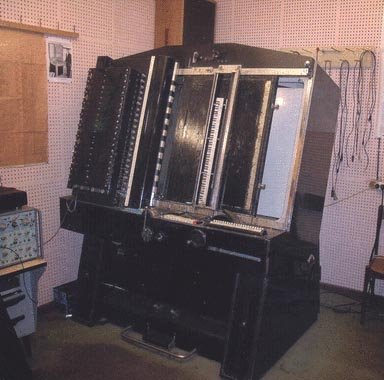 [Image: The ANS].
[Image: The ANS].The ANS functioned through an "array of tiny chisels" that engraved "lines and points on rotating black enamelled glass discs." These engravings would then "regulate the brightness of light rays" that passed "through the discs onto photoelements," like the sun streaming through carefully shaded windows.
The "level of intensity" of this light then produced specific sounds.
Elsewhere (scroll down in this link till you hit the COILANS review), we read about the ANS's unique compositional process: "The composer inscribes his visual 'score' onto a glass plate covered with sticky black mastic, slides it through the machine, which reads the inscribed plate and converts the etchings into sound produced by a system of 800 oscillators."
It's a machine that reads windows.
 [Image: A representative musical score for the ANS – but what if you fed it architectural diagrams?].
[Image: A representative musical score for the ANS – but what if you fed it architectural diagrams?].The Wire then explains that, in 2002, British band Coil visited the synthesizer in Moscow and recorded nearly 4 hours of music using the machine. Listening to what they produced, we're told, sounds "like travelling through the Oort Cloud or the Kuiper Belt – glitting slivers of distant white light and vast, nebulous spaces populated by inchoate radioactive matter." As you'll notice in these three, 3-minute samples, the effect is certainly weird – but unbelievably mesmerizing: 1, 2, and 3 (all MP3s).
Light, chisels, glass plates, oscillators, enamelled surfaces, engravings on windows – with these elements it is not at all hard to imagine a kind of ANS architecture, rebuilt on the scale of a building. Windowed lobbies and escalators; sunlight; entire lift shafts full of glass discs, inscribed and black-enamelled, emitting music like light. Whole rooms of sound, angelic, the windows slightly trembling.
Moving panes of glass, washed clean at the end of the day, pass slowly behind curtains, casting shadows.
A symphony for glass escalators. Chamber music.
Entire cities, made from nothing but windows, tuning to each other – like the sound of orchestral sunlight.
(Note: The ANS was apparently used to soundtrack Andrei Tarkovsky's films Solaris and Stalker).
No comments:
Post a Comment